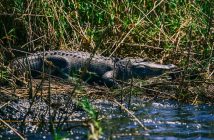“Platinum 3-5, Platinum 3-5, request descent to 500 feet, altering course to FL320, over…”
“Go ahead, Platinum 3-5. What’s your revised ETA, over.”
“Oh, we won’t be more than five minutes, over”.
Gerald turns to me and asks, “Do you fancy a bit of shark-spotting?” What do you mean shark ‘spotting’? Actual sharks? Sharks in the sea, sharks? “Sure, are you in a hurry to get to George?” I don’t think so.
“Okay, let’s go.”
Thirty minutes earlier, I was excited as a schoolboy filming from the seat of a private jet, taking off out of Cape Town. It’s not enough to turn left when boarding any more. There’s only one way to fly now: your own plane. As if that wasn’t thrilling enough, our pilot, Gerald, after the safety briefing asked if any of us would like to sit with him up in the cockpit. I nearly dislocated my shoulder throwing my arm in the air so quickly. And right now, I’m beside myself. It just couldn’t get any better.
So here I am, I’ve got the cans on, listening to the intercom between Gerald and the tower at George, it’s all I can do to ask what each of the instruments do, and what happens if I flick this switch, and…he senses my excitement, takes us off autopilot and lets me grip the controls. At this point we begin descending. We are, literally, going shark-spotting.

I may have been disappointed not to be driving the infamous ‘Garden Route’ in a classic car – definitely worth a go if you get the opportunity, I’m told – but, really, that’s no great loss when you can see it from the air. We may not be able to spot the individual flora but this way gives you a terrific overview of the region. We’re at 500 feet, have drifted over to the coast, and it feels like we’re almost touching the treetops amid the palatial villas that dot the countryside. We round the point heading into Mossel Bay and I can practically smell the surf. I start peering through the cockpit into the sea; I can’t imagine we’ll see a shark, how does that work?
Suddenly, Gerald leaps, ‘There! There!’ and takes the plane into a steep bank left. We circle and, sure enough, the slinking silhouette of a great white is below us. I am incredulous. Then we spot another, and another. There are about half a dozen a mere 100 feet from the breakers. Where there are people in the water. “I’ve had to call the coastguard before if I saw anyone in the water out there,” Gerald tells me. I can well believe it. The man is nothing short of a hero and I feel utterly inadequate in his company. I can barely adjust the aircon in my car and hold a straight line, let alone spot a shark from a Learjet at 500 feet.
That flight alone would have been thrilling enough. A big bucket list tick. But the journey into the garden route was barely an hour in and we hadn’t even been into the ‘garden’.
Most visitors to the Cape don’t set foot out of Cape Town itself. But the ‘town’ part is a mere fraction of what’s on offer. Halfway across the southernmost region of South Africa, to Port Elizabeth, deep into the this colourful, beautiful region, is George. If, I may say, a rather nondescript town save one definitely not nondescript asset: Fancourt.

To describe Fancourt in a catchy, catch-all phrase is a challenge. It’s a country estate, but it’s not. It’s a leisure resort, but it’s so much more than that. It’s a lifestyle. Even its own website can’t describe exactly what it is, it simply shows you a delightful aerial image of jade green lawns and pleasant houses and acres of land receding off into the Outeniqua mountains in the distance.
What it is, is big. It covers a considerable 613 hectares, or 6 square kilometres. To put that into perspective, it is roughly the size of a typical English village. And that, in fact, is not a bad way to describe it. It has a central hub, of a hotel, a clubhouse, a spa – okay, this is turning into quite the perfect English village – then there are three areas of serviced villas and suites and several private homes, with more in development for sale. The residences themselves are clustered in a village-like layout, many of which are thatched. So far, so quintessential. And, like any self-respecting English village there is also The Manor which, in Fancourt’s case, is an 18-suite adult-only boutique hotel. And all this is bundled in beautifully-managed, often manicured gardens; Fancourt’s borders brim with proteas, lilies and bourganvillea, its lawns wandered by ibis and guinea fowl.
In such idyllic surrounds, simply strolling around Fancourt could certainly pass the day, if so desired, with the odd dip in the outdoor pool, a soothing soak in the Roman bath spa or beer in the bar, but there is one thing that gives Fancourt its renown. It’s what motivates the keenest enthusiast to purchase property here, and has begrudging wives dragged here on an elemental indulgence: golf. Fancourt’s acreage houses not one, but three, golf courses, cleverly integrated into the grounds. My own villa, in fact, backed onto one of the fairways, the reed pond in the garden serving as a canny water obstacle. And I found a friendly wave and breezy ‘hello’ from passing players often accompanied a sundowner on my patio.

On the fringes of the estate, however, out of the reaches of mere mortals, sits a links course that redefines exclusivity. Designed by Gary Player (SA’s most famous golfer), it is the pride and joy of Fancourt’s owner, is South Africa’s best and regularly features in the world’s top listings. Playing it, however, is by invitation only – if you can afford the $100,000 green fees. Its clubhouse has been graced by golfing legends, the great and the good of the game…and one visiting journalist, with a mighty slice. I nearly couldn’t believe my luck, limbering up my driving arm, until I was told that the course was closed for two days of upkeep. Still, it was enough to have picked up Ernie Els’ clubs and I settled instead for a few holes on the Montagu.
The Garden Route is given its name as a product of its micro-climate, itself created by the natural sun trap of its latitude and the thread of the fold mountains that run across its length, trapping precipitation. And it’s because of this climate that 80% of South Africa’s flora, some 9000 species, are found here. There are more plant species per land area in the Western Cape than anywhere else in the world, including the Amazon. A rich garden indeed. And at the other end of the spectrum from the horticultured desirability of Fancourt is another estate, slowly making its impact on the world. But it’s not golfers that roam here, but game. Big game.

A visit to Botlierskop is not a substitute for going on a safari, but it’s a close second. If Fancourt is South Africa’s Stourhead, then Botlierskop is their Longleat. A private game reserve set amid craggy veld, it’s a passion project that is largely made up of reclaimed farmland and has set about re-establishing the natural terroir through a process of ‘feinbos’, a fire-driven regenerative system that allows the land to return to its original make-up. And within this tiny corner of the Western Cape, on a bumpy game drive in a classic open-top 4×4, one can experience something often far better than that on offer from massive open savannah; you can actually tick off the ‘big five’.
We encountered herds of Cape zebra, eland and wildebeest even before we’d left the ranch compound. During our drive, on a glorious crisp spring morning, across a valley a lone elephant silhouetted against the crystal blue sky; and, as we rounded the valley floor, next to a babbling creek, a rhino stood idly chewing cud by the riverbank to be disturbed only by a pair of bontebok that cantered into view. I’m not making this up; we sat a while, watching a mother elephant and her calf chew down half a tree and, near our final stop, on the outer edge of the estate, having had the stuffing shaken out of me grinding and revving over a rocky track exposed by recent rainfall, we came face to face with a curious giraffe calf who, joined by its mother, ambled off, their awkward, loping gait giving them an otherworldly quality, like something from a Philip Pullman novel.

It’s not all perfect, though. Our final stop, the other side of the estate, was to the lions. Through a fence, in a separate self-contained habitat, lived Chris, a dominant male, who had been retired from the ‘catwalk’ – a tourist promotion, literally walking with lions – and, with two ladies to accompany him, was to be gradually given more and more land and eventually reintroduced into a natural habitat once more. Botlierskop may not yet be the ‘wild’ habitat one might hope for but they know conservation, and regeneration, and they’re on the right track to reinstating what the wildlife of this mighty continent once stood for.
Two days was not enough to fully embrace what Fancourt and its environs has to offer but, between reshaping the Monatgu’s 17th fairway into a lunar surface, feeling the sun on my back atop an escarpment at Botlierskop, enjoying fine wine over dinner at The Manor, I can think of little else I’d rather have done in South Africa’s garden.
Oh, and did I mention the shark-spotting from a private plane?
Fancourt is South Africa’s premier golfing destination, among so much more. Fore (sorry) more information on the golf courses, facilities, details on villas, hotels and private residences and, of course, that Links course, visit www.fancourt.com. Fancourt is a member of the Leading Hotels of the World.
For more information about Botlierskop private game reserve, including its regeneration programme, visit www.botlierskop.co.za.
Fancourt and the Manor House have been nominated in several categories at the 2016 World Luxury Hotel Awards, including Luxury Golf Resort, Best Garden Resort and Best Scenic Environment. For more information, and to register to vote, visit www.luxuryhotelawards.com. Voting closes on Friday 5th August 2016.




